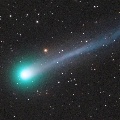
|
Now it is 4.8 mag (Oct. 16, Yoshimi Nagai). It will turn to fade out rapidly after the peak. In the Northern Hemisphere, it will be unobservable in November. In the Southern Hemisphere, it is not observable now, but it will appear in December.
Date(TT) R.A. (2000) Decl. Delta r Elong. m1 Best Time(A, h)
Oct. 18 13 23.10 36 39.7 0.612 0.723 46 4.5 4:44 (233, 12)
Oct. 25 15 17.77 19 54.6 0.623 0.628 37 4.0 18:38 (102, 17)
|
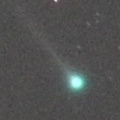
|
Now it is 5.8 mag (Oct. 15, Chris Wyatt). It will fade out rapidly after this. It stays observable in good condition.
Date(TT) R.A. (2000) Decl. Delta r Elong. m1 Best Time(A, h)
Oct. 18 18 14.58 -14 29.9 0.265 0.936 69 6.1 18:45 ( 38, 32)
Oct. 25 20 23.62 -7 55.8 0.281 1.056 94 6.8 18:38 ( 8, 47)
|

|
It brightened up to 10.6 mag until mid September (Sept. 16, Thomas Lehmann). It will fade out rapidly after this. It will be fainter than 18 mag in February. In the Northern Hemisphere, it will be getting higher gradually. In the Southern Hemisphere, it is not observable now, but it will be observable soon.
Date(TT) R.A. (2000) Decl. Delta r Elong. m1 Best Time(A, h)
Oct. 18 12 3.61 -6 57.1 1.155 0.434 21 8.4 4:44 (280, 1)
Oct. 25 11 49.20 -1 43.1 0.997 0.572 33 9.3 4:49 (282, 14)
|
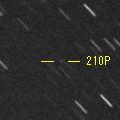
|
It is expected to brighten up to 8 mag from late autumn to early winter. Now it is 16.3 mag (Oct. 2, ATLAS Chile). It brightens up to 8.5 mag, but it will turn to fade out rapidly after that. It will be unobservable soon in the Northern Hemisphere, or in November in the Southern Hemisphere. But it will be observable again in November in the Northern Hemisphere, or in December in the Southern Hemisphere. It is much fainter than this ephemeris recently.
Date(TT) R.A. (2000) Decl. Delta r Elong. m1 Best Time(A, h)
Oct. 18 17 40.54 -41 11.0 0.514 0.891 63 11.8 18:45 ( 31, 4)
Oct. 25 17 13.96 -40 8.7 0.481 0.790 51 10.9 18:38 ( 39, -1)
|
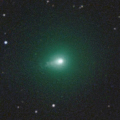
|
Third interstellar object in history following 1I/'Oumuamua and 2I/Borisov. The eccentricity is extremely big as 6. It approaches to Sun down to 1.38 a.u. in late October. Now it is 10.8 mag (Oct. 2, Thomas Lehmann). It will turn to fade out rapidly after the peak. Now it is not observable. It will appear in November.
Date(TT) R.A. (2000) Decl. Delta r Elong. m1 Best Time(A, h)
Oct. 18 13 52.85 -8 41.0 2.409 1.420 5 11.4 18:45 ( 89,-13)
Oct. 25 13 38.94 -7 39.6 2.351 1.366 6 11.2 4:49 (271,-12)
|
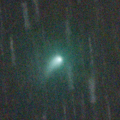
|
It is expected to brighten up to 5 mag in January. Now it is 13.1 mag (Sept. 21, Seiichi Yoshida). It will brighten rapidly after this. It will be unobservable soon in the Southern Hemisphere, or in December in the Northern Hemisphere. But it will be observable again in January in the Southern Hemisphere, or in February in the Northern Hemisphere.
Date(TT) R.A. (2000) Decl. Delta r Elong. m1 Best Time(A, h)
Oct. 18 16 29.02 14 59.0 2.352 1.882 50 11.6 18:45 ( 86, 32)
Oct. 25 16 37.84 11 36.5 2.313 1.778 46 11.3 18:38 ( 84, 28)
|
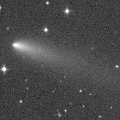
|
Now it is brighter than originally expected. Now it is 13.1 mag (Sept. 30, Hiroshi Abe). It stays 13 mag for a while. It stays observable in good condition. It is expected to brighten up to 12 mag and to be observable in good condition from autumn to winter. A 19-mag fragment was found on Oct. 3.
Date(TT) R.A. (2000) Decl. Delta r Elong. m1 Best Time(A, h)
Oct. 18 4 15.04 0 51.5 1.332 2.179 138 12.5 2:30 ( 0, 56)
Oct. 25 4 12.25 1 32.3 1.276 2.167 144 12.4 2:00 ( 0, 57)
|

|
Bright new comet. Now it is 12.4 mag (Oct. 21, Martin Masek). It brightens up to 11.5 mag, but it will turn to fade out rapidly after that. In the Northern Hemisphere, it will be unobservable in January. In the Southern Hemisphere, it is not observable now.
Date(TT) R.A. (2000) Decl. Delta r Elong. m1 Best Time(A, h)
Oct. 18 11 59.30 51 6.5 1.421 1.327 63 13.0 4:44 (227, 31)
Oct. 25 12 56.69 53 59.6 1.264 1.270 67 12.5 4:49 (222, 29)
|
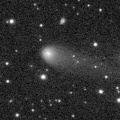
|
Now it is 13.9 mag (Sept. 23, Osamu Miyazaki). It stays 14 mag for a while. In the Northern Hemisphere, it stays observable in good condition. It locates somewhat low in the Southern Hemisphere.
Date(TT) R.A. (2000) Decl. Delta r Elong. m1 Best Time(A, h)
Oct. 18 3 34.38 26 32.1 3.019 3.887 146 13.3 1:50 ( 0, 82)
Oct. 25 3 32.39 26 32.0 2.984 3.898 153 13.3 1:20 ( 0, 82)
|
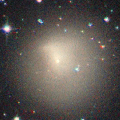
|
It will be getting higher gradually.
Date(TT) R.A. (2000) Decl. Delta r Elong. m1 Best Time(A, h)
Oct. 18 11 8.07 1 2.3 7.065 6.298 37 14.2 4:44 (281, 17)
Oct. 25 11 12.06 0 30.6 6.992 6.299 42 14.2 4:49 (286, 23)
|
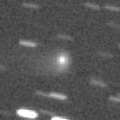
|
It is expected to brighten up to 13 mag in early summer in 2026. Now it is 14.4 mag (Sept. 12, Andrew Pearce). It stays 14 mag for a while. It will be getting lower gradually after this, and it will be unobservable in January in the Northern Hemisphere, or in December in the Southern Hemisphere. But it will be observable again in January in the Northern Hemisphere, or in February in the Southern Hemisphere.
Date(TT) R.A. (2000) Decl. Delta r Elong. m1 Best Time(A, h)
Oct. 18 19 20.18 7 43.0 3.808 3.914 88 14.3 18:45 ( 36, 58)
Oct. 25 19 16.96 6 17.9 3.909 3.889 81 14.4 18:38 ( 43, 54)
|
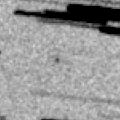
|
It will brighten up to 8 mag in winter, and will be observable in good condition. Now it is 15.9 mag (Oct. 1, Thomas Lehmann). Brightening rapidly. In the Northern Hemisphere, it stays observable in good condition. It locates somewhat low in the Southern Hemisphere. But it will become high in winter.
Date(TT) R.A. (2000) Decl. Delta r Elong. m1 Best Time(A, h)
Oct. 18 7 19.94 19 48.2 1.135 1.583 95 15.3 4:44 (321, 71)
Oct. 25 7 43.18 20 1.1 1.041 1.529 97 14.4 4:49 (327, 73)
|

|
Now it is 14.8 mag (Sept. 27, Ken-ichi Kadota). It stays 15 mag for a while. It will be unobservable soon in the Southern Hemisphere, or in November in the Northern Hemisphere. But it will be observable again in January in the Southern Hemisphere, or in December in the Northern Hemisphere.
Date(TT) R.A. (2000) Decl. Delta r Elong. m1 Best Time(A, h)
Oct. 18 15 50.17 -1 13.3 6.632 5.851 35 14.5 18:45 ( 78, 15)
Oct. 25 15 55.57 -1 15.6 6.706 5.878 31 14.6 18:38 ( 80, 12)
|
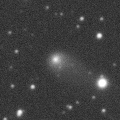
|
Now it is 15.6 mag (Sept. 28, Alfons Diepvens). It stays 15 mag for a while. In the Northern Hemisphere, it stays observable in good condition. It locates somewhat low in the Southern Hemisphere.
Date(TT) R.A. (2000) Decl. Delta r Elong. m1 Best Time(A, h)
Oct. 18 9 6.79 19 15.9 5.724 5.483 71 14.7 4:44 (284, 52)
Oct. 25 9 11.03 19 28.4 5.620 5.485 77 14.6 4:49 (290, 58)
|

|
Now it is 17.7 mag (July 24, Thomas Lehmann). It will brighten rapidly after this. Now it is not observable. It will appear in January in the Southern Hemisphere, or in December in the Northern Hemisphere.
Date(TT) R.A. (2000) Decl. Delta r Elong. m1 Best Time(A, h)
Oct. 18 13 36.39 -8 24.7 3.053 2.058 1 15.0 18:45 ( 91,-16)
Oct. 25 13 51.06 -9 55.4 3.004 2.011 2 14.7 4:49 (271,-16)
|
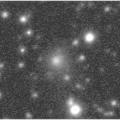
|
It will brighten up to 13 mag in 2026. Now it is 15.4 mag (Oct. 2, ATLAS-MLO, Mauna Loa). It stays 15 mag for a while. It will be getting lower gradually after this, and it will be unobservable in December. But it will be observable again in January in the Northern Hemisphere.
Date(TT) R.A. (2000) Decl. Delta r Elong. m1 Best Time(A, h)
Oct. 18 18 33.57 -10 16.2 5.347 5.168 74 15.0 18:45 ( 38, 37)
Oct. 25 18 35.56 -9 50.6 5.417 5.131 68 15.0 18:38 ( 42, 35)
|
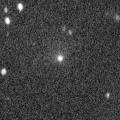
|
Very large comet. It is expected to brighten up to 13 mag in 2031. Now it is 15.3 mag (Sept. 29, Andrew Pearce). It stays 15 mag for a while. In the Northern Hemisphere, it is not observable now. In the Southern Hemisphere, it stays observable in good condition. In the Northern Hemisphere, it is not observable until 2030.
Date(TT) R.A. (2000) Decl. Delta r Elong. m1 Best Time(A, h)
Oct. 18 5 41.99 -72 47.8 14.626 14.636 88 15.0 3:55 ( 0,-18)
Oct. 25 5 40.50 -73 13.8 14.620 14.614 87 15.0 3:26 ( 0,-18)
|

|
Now it is 16.3 mag (Sept. 28, Alfons Diepvens). It stays 15 mag for a while. In the Northern Hemisphere, it stays observable in good condition. In the Southern Hemisphere, it will be getting higher gradually.
Date(TT) R.A. (2000) Decl. Delta r Elong. m1 Best Time(A, h)
Oct. 18 9 55.96 4 50.0 2.929 2.501 55 15.0 4:44 (290, 34)
Oct. 25 10 6.32 3 33.0 2.868 2.513 59 15.0 4:49 (296, 37)
|
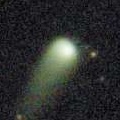
|
It was observed at 12-13 mag for a long time in 2024. Now it is 14.8 mag (Oct. 2, Thomas Lehmann). Fading slowly. In the Northern Hemisphere, it stays observable in good condition. In the Southern Hemisphere, it will be unobservable in December.
Date(TT) R.A. (2000) Decl. Delta r Elong. m1 Best Time(A, h)
Oct. 18 22 57.95 48 56.3 4.358 5.049 129 15.2 21:09 (180, 76)
Oct. 25 22 49.35 47 2.9 4.423 5.089 127 15.3 20:33 (180, 78)
|
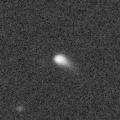
|
Now it is 15.1 mag (Oct. 2, ATLAS Chile). It stays 15 mag for a while. It stays extremely low in the Northern Hemisphere. But it will become high in autumn. In the Southern Hemisphere, it stays observable in good condition. It is expected to brighten up to 12 mag in winter between 2026 and 2027.
Date(TT) R.A. (2000) Decl. Delta r Elong. m1 Best Time(A, h)
Oct. 18 3 13.34 -45 47.1 5.528 6.090 120 15.5 1:28 ( 0, 9)
Oct. 25 3 9.49 -46 1.1 5.492 6.048 119 15.5 0:57 ( 0, 9)
|
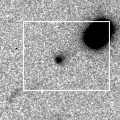
|
It is expected to brighten up to 13.5 mag and to be observable in good condition in 2026 spring. Now it is 16.8 mag (Aug. 12, ATLAS South Africa). Brightening slowly. In the Northern Hemisphere, it is not observable now, but it will appear in December. It stays extremely low in the Southern Hemisphere. But it will become high in winter.
Date(TT) R.A. (2000) Decl. Delta r Elong. m1 Best Time(A, h)
Oct. 18 13 52.07 -57 2.7 2.557 2.026 47 15.6 18:45 ( 40,-34)
Oct. 25 14 8.30 -54 56.3 2.585 1.977 43 15.5 18:38 ( 43,-34)
|

|
It will brighten up to 12 mag in 2026 summer. Now it is 16.2 mag (Sept. 18, Francois Kugel). Brightening slowly. It will be getting lower gradually after this, and it will be unobservable in January in the Southern Hemisphere, or in February in the Northern Hemisphere.
Date(TT) R.A. (2000) Decl. Delta r Elong. m1 Best Time(A, h)
Oct. 18 20 0.95 -13 53.0 2.502 2.772 94 15.9 18:45 ( 10, 41)
Oct. 25 20 6.28 -13 55.0 2.566 2.740 89 15.9 18:38 ( 15, 40)
|

|
Now it is 15.5 mag (Sept. 29, ATLAS Chile). Fading slowly. In the Northern Hemisphere, it stays observable in good condition. In the Southern Hemisphere, it will be getting lower gradually after this, and it will be unobservable in February.
Date(TT) R.A. (2000) Decl. Delta r Elong. m1 Best Time(A, h)
Oct. 18 22 38.67 -10 4.4 2.033 2.808 132 16.0 20:51 ( 0, 45)
Oct. 25 22 38.02 -9 32.4 2.105 2.808 126 16.1 20:22 ( 0, 46)
|
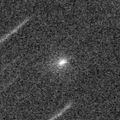
|
It brightened very rapidly. Now it is 15.0 mag (Sept. 23, Ken-ichi Kadota). Fading rapidly. It will be fainter than 18 mag soon. It will never be observable after this.
Date(TT) R.A. (2000) Decl. Delta r Elong. m1 Best Time(A, h)
Oct. 18 12 26.99 -13 43.6 1.589 0.690 16 16.1 4:44 (282, -7)
Oct. 25 12 58.75 -17 17.6 1.699 0.784 15 17.7 4:49 (285, -9)
|

|
It brightened up to 12.7 mag in 2024 summer (Aug. 7, 2024, Thomas Lehmann). Now it is 15.7 mag (Sept. 23, ATLAS-MLO, Mauna Loa). Fading slowly. In the Northern Hemisphere, it stays observable in good condition. In the Southern Hemisphere, it will never be observable after this.
Date(TT) R.A. (2000) Decl. Delta r Elong. m1 Best Time(A, h)
Oct. 18 22 19.90 56 18.4 3.636 4.228 120 16.1 20:31 (180, 69)
Oct. 25 22 17.60 55 27.3 3.707 4.283 119 16.2 20:02 (180, 69)
|
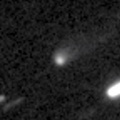
|
Now it is 16.3 mag (Sept. 25, ATLAS South Africa). It stays 17 mag for a while. It will be unobservable in January.
Date(TT) R.A. (2000) Decl. Delta r Elong. m1 Best Time(A, h)
Oct. 18 18 59.43 -30 39.5 3.025 2.990 78 16.2 18:45 ( 21, 21)
Oct. 25 19 8.48 -30 19.2 3.123 2.997 73 16.2 18:38 ( 24, 20)
|

|
Now it is 16.6 mag (Oct. 3, Thomas Lehmann). It stays 16 mag for a while. In the Northern Hemisphere, it stays observable in good condition. In the Southern Hemisphere, it will be unobservable in December.
Date(TT) R.A. (2000) Decl. Delta r Elong. m1 Best Time(A, h)
Oct. 18 8 49.44 33 52.5 4.091 4.029 79 16.3 4:44 (262, 61)
Oct. 25 8 52.33 35 25.8 3.991 4.046 86 16.3 4:49 (261, 68)
|

|
Now it is 16.6 mag (Oct. 2, ATLAS-MLO, Mauna Loa). It stays 16 mag for a while. It stays observable in good condition.
Date(TT) R.A. (2000) Decl. Delta r Elong. m1 Best Time(A, h)
Oct. 18 8 49.92 -11 23.5 6.868 6.575 68 16.4 4:44 (318, 33)
Oct. 25 8 52.48 -11 34.7 6.777 6.578 74 16.3 4:49 (326, 37)
|
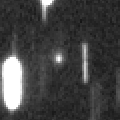
|
Now it is 16.7 mag (Sept. 18, Francois Kugel). It stays 17 mag for a while. In the Northern Hemisphere, it stays observable in good condition. In the Southern Hemisphere, it will be getting lower gradually after this, and it will be unobservable in February.
Date(TT) R.A. (2000) Decl. Delta r Elong. m1 Best Time(A, h)
Oct. 18 20 11.36 -15 14.5 1.716 2.088 97 16.5 18:45 ( 7, 40)
Oct. 25 20 20.68 -14 39.8 1.778 2.075 92 16.5 18:38 ( 10, 40)
|

|
Now it is 16.7 mag (Sept. 30, Thomas Lehmann). It stays 17 mag for a while. It locates somewhat low in the Northern Hemisphere. But it will become high in winter. In the Southern Hemisphere, it will never be observable after this.
Date(TT) R.A. (2000) Decl. Delta r Elong. m1 Best Time(A, h)
Oct. 18 14 29.29 63 20.8 4.582 4.407 73 16.5 18:45 (149, 30)
Oct. 25 14 49.81 63 24.1 4.552 4.419 76 16.5 18:38 (149, 31)
|
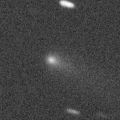
|
It brightened up to 12.1 mag in early summer (June 10, Taras Prystavski). Now it is 15.8 mag (Oct. 1, Katsumi Yoshimoto). Fading gradually. It will be fainter than 18 mag in January. In the Northern Hemisphere, it stays observable in good condition. In the Southern Hemisphere, it will be getting higher gradually.
Date(TT) R.A. (2000) Decl. Delta r Elong. m1 Best Time(A, h)
Oct. 18 8 49.96 12 59.4 2.166 2.107 73 16.6 4:44 (296, 51)
Oct. 25 8 57.85 12 43.3 2.136 2.165 78 16.7 4:49 (303, 56)
|

|
It brightened very rapidly, and it became brighter than expected. Now it is 15.8 mag (Sept. 27, Katsumi Yoshimoto). Fading slowly. It will be fainter than 18 mag in January. It stays observable in good condition.
Date(TT) R.A. (2000) Decl. Delta r Elong. m1 Best Time(A, h)
Oct. 18 0 26.81 -5 31.9 2.491 3.436 158 16.7 22:38 ( 0, 50)
Oct. 25 0 23.46 -5 48.5 2.543 3.445 150 16.8 22:07 ( 0, 49)
|

|
Now it is 16.9 mag (Sept. 28, Alfons Diepvens). It stays 17 mag for a while. In the Northern Hemisphere, it stays observable in good condition. It stays extremely low in the Southern Hemisphere.
Date(TT) R.A. (2000) Decl. Delta r Elong. m1 Best Time(A, h)
Oct. 18 5 16.50 49 49.8 3.283 3.860 118 16.9 3:32 (180, 75)
Oct. 25 5 16.16 50 40.8 3.207 3.854 124 16.8 3:04 (180, 74)
|

|
Now it is 17.3 mag (Oct. 1, ATLAS-MLO, Mauna Loa). It stays 17 mag for a while. It stays observable in good condition.
Date(TT) R.A. (2000) Decl. Delta r Elong. m1 Best Time(A, h)
Oct. 18 22 17.10 -21 19.3 1.401 2.119 123 16.9 20:29 ( 0, 34)
Oct. 25 22 18.31 -20 6.4 1.440 2.092 117 16.9 20:03 ( 0, 35)
|
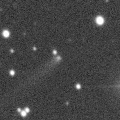
|
Now it is 16.9 mag (July 13, Taras Prystavski). It stays 17 mag for a while. It locates somewhat low in the Northern Hemisphere. But it will become high in spring. In the Southern Hemisphere, it will be getting higher gradually.
Date(TT) R.A. (2000) Decl. Delta r Elong. m1 Best Time(A, h)
Oct. 18 11 1.67 -22 49.7 6.290 5.540 38 16.9 4:44 (301, 3)
Oct. 25 11 2.58 -23 4.6 6.245 5.558 42 16.9 4:49 (306, 9)
|

|
Now it is 16.9 mag (Oct. 3, ATLAS-MLO, Mauna Loa). It stays 17 mag for a while. In the Northern Hemisphere, it stays observable in good condition. In the Southern Hemisphere, it will never be observable after this.
Date(TT) R.A. (2000) Decl. Delta r Elong. m1 Best Time(A, h)
Oct. 18 8 45.91 78 43.2 4.921 5.118 95 17.0 4:44 (189, 44)
Oct. 25 9 10.84 80 11.5 4.866 5.112 98 16.9 4:49 (187, 43)
|
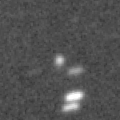
|
Brightening rapidly. It is expected to brighten up to 13 mag from 2027 to 2028. Now it is 17.0 mag (Sept. 30, Thomas Lehmann). It stays 17 mag for a while. In the Northern Hemisphere, it stays observable in good condition. In the Southern Hemisphere, it will be getting lower gradually after this, and it will be unobservable in December.
Date(TT) R.A. (2000) Decl. Delta r Elong. m1 Best Time(A, h)
Oct. 18 21 37.36 22 47.0 6.649 7.236 122 17.0 19:49 ( 0, 78)
Oct. 25 21 34.54 22 27.7 6.693 7.197 116 17.0 19:19 ( 0, 78)
|
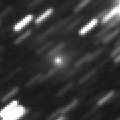
|
Very far object. Now it is 17.4 mag (July 26, ATLAS South Africa). It stays 17 mag for a while. In the Northern Hemisphere, it is not observable now, but it will appear in December. In the Southern Hemisphere, it stays observable in good condition.
Date(TT) R.A. (2000) Decl. Delta r Elong. m1 Best Time(A, h)
Oct. 18 0 33.53 -57 15.9 10.554 10.970 112 17.0 22:45 ( 0, -2)
Oct. 25 0 28.50 -56 56.4 10.624 10.983 108 17.0 22:12 ( 0, -2)
|
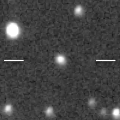
|
Although it is around 20 mag usually, now it is bright in outburst. Now it is 17.1 mag (Oct. 13, Ken-ichi Kadota). It stays 17 mag for a while. In the Northern Hemisphere, it stays observable in good condition. It stays extremely low in the Southern Hemisphere.
Date(TT) R.A. (2000) Decl. Delta r Elong. m1 Best Time(A, h)
Oct. 18 3 7.64 38 30.2 8.056 8.879 143 17.1 1:23 (180, 86)
Oct. 25 3 5.14 38 32.2 7.998 8.869 149 17.1 0:53 (180, 86)
|

|
Now it is 16.9 mag (Oct. 13, Ken-ichi Kadota). It stays 17 mag for a while. In the Northern Hemisphere, it stays observable in good condition. It locates somewhat low in the Southern Hemisphere.
Date(TT) R.A. (2000) Decl. Delta r Elong. m1 Best Time(A, h)
Oct. 18 10 0.24 20 32.5 2.466 2.146 59 17.2 4:44 (273, 42)
Oct. 25 10 12.70 20 14.5 2.430 2.184 63 17.1 4:49 (277, 46)
|
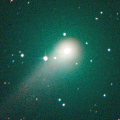
|
It was observed at 9-10 mag for a long time in 2023. It is fading very slowly. Now it is 16.9 mag (Sept. 29, ATLAS South Africa). It stays 17 mag for a while. In the Northern Hemisphere, it will never be observable after this. In the Southern Hemisphere, it will be getting lower gradually. But it will be getting higher again after January.
Date(TT) R.A. (2000) Decl. Delta r Elong. m1 Best Time(A, h)
Oct. 18 18 53.20 -69 15.8 8.690 8.535 77 17.1 18:45 ( 9,-16)
Oct. 25 18 54.00 -68 40.2 8.822 8.586 73 17.2 18:38 ( 11,-16)
|

|
Now it is 17.7 mag (Sept. 18, Hidetaka Sato). It stays 17 mag for a while. It locates somewhat low in the Northern Hemisphere. In the Southern Hemisphere, it stays observable in good condition.
Date(TT) R.A. (2000) Decl. Delta r Elong. m1 Best Time(A, h)
Oct. 18 9 31.48 -19 24.1 4.892 4.453 58 17.2 4:44 (314, 20)
Oct. 25 9 36.60 -20 35.0 4.822 4.456 62 17.1 4:49 (321, 23)
|
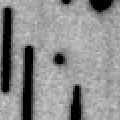
|
Now it is 17.5 mag (Sept. 23, Ken-ichi Kadota). Fading slowly. It will be fainter than 18 mag in December. In the Northern Hemisphere, it will be getting lower gradually. In the Southern Hemisphere, it will never be observable after this.
Date(TT) R.A. (2000) Decl. Delta r Elong. m1 Best Time(A, h)
Oct. 18 18 54.71 72 21.6 1.655 2.024 96 17.2 18:45 (168, 51)
Oct. 25 18 43.69 65 8.4 1.686 2.007 93 17.2 18:38 (157, 54)
|
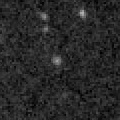
|
Now it is 17.3 mag (Oct. 13, Ken-ichi Kadota). It stays 17 mag for a while. In the Northern Hemisphere, it stays observable in good condition. In the Southern Hemisphere, it is not observable now.
Date(TT) R.A. (2000) Decl. Delta r Elong. m1 Best Time(A, h)
Oct. 18 11 15.95 70 4.2 4.166 4.161 82 17.3 4:44 (205, 39)
Oct. 25 11 18.22 70 31.5 4.064 4.131 86 17.2 4:49 (204, 41)
|

|
Now it is 17.3 mag (Oct. 13, ATLAS-TDO). It stays 17 mag for a while. In the Northern Hemisphere, it stays observable in good condition. In the Southern Hemisphere, it will be getting higher gradually.
Date(TT) R.A. (2000) Decl. Delta r Elong. m1 Best Time(A, h)
Oct. 18 4 15.82 40 6.2 1.822 2.599 132 17.5 2:32 (180, 85)
Oct. 25 4 3.54 37 21.2 1.696 2.554 142 17.2 1:52 (180, 87)
|
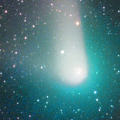
|
It brightened up to 8 mag from 2022 summer to 2023 spring. Now it is 17.2 mag (Sept. 28, Alfons Diepvens). It stays 18 mag for a while. In the Northern Hemisphere, it stays observable in good condition. It locates somewhat low in the Southern Hemisphere.
Date(TT) R.A. (2000) Decl. Delta r Elong. m1 Best Time(A, h)
Oct. 18 6 18.06 28 57.0 9.378 9.771 110 17.4 4:33 ( 0, 84)
Oct. 25 6 16.55 29 10.1 9.318 9.820 117 17.4 4:04 ( 0, 84)
|
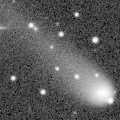
|
Now it is 17.1 mag (Sept. 2, Andrew Pearce). It stays 18 mag for a while. It stays extremely low in the Northern Hemisphere. In the Southern Hemisphere, it stays observable in good condition.
Date(TT) R.A. (2000) Decl. Delta r Elong. m1 Best Time(A, h)
Oct. 18 5 48.80 -45 18.7 8.140 8.378 100 17.4 4:03 ( 0, 10)
Oct. 25 5 44.50 -45 57.1 8.144 8.422 102 17.4 3:31 ( 0, 9)
|
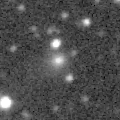
|
Now it is 17.0 mag (Sept. 25, ATLAS-MLO, Mauna Loa). Fading slowly. It will be fainter than 18 mag in December. It will be getting lower gradually.
Date(TT) R.A. (2000) Decl. Delta r Elong. m1 Best Time(A, h)
Oct. 18 19 52.72 -14 20.0 5.002 5.149 92 17.4 18:45 ( 13, 40)
Oct. 25 19 55.85 -14 2.5 5.137 5.177 86 17.5 18:38 ( 18, 39)
|
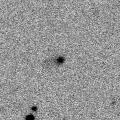
|
It continues brightening even after the perihelion passage. Now it is 17.5 mag (Oct. 1, ATLAS Chile). It stays 18 mag for a while. In the Northern Hemisphere, it will never be observable after this. In the Southern Hemisphere, it stays observable in good condition.
Date(TT) R.A. (2000) Decl. Delta r Elong. m1 Best Time(A, h)
Oct. 18 0 44.91 -68 43.8 5.435 5.715 101 17.4 22:55 ( 0,-14)
Oct. 25 0 25.79 -68 14.7 5.515 5.741 98 17.5 22:08 ( 0,-13)
|
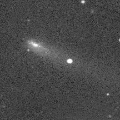
|
Now it is 16.2 mag (Sept. 30, Thomas Lehmann). Fading slowly. It will be fainter than 18 mag in November. It stays observable in good condition.
Date(TT) R.A. (2000) Decl. Delta r Elong. m1 Best Time(A, h)
Oct. 18 3 56.03 3 22.9 1.762 2.630 143 17.4 2:11 ( 0, 58)
Oct. 25 3 51.37 3 2.8 1.750 2.660 150 17.6 1:39 ( 0, 58)
|

|
Now it is 17.7 mag (June 26, ATLAS Chile). It stays 18 mag for a while. It stays observable in good condition.
Date(TT) R.A. (2000) Decl. Delta r Elong. m1 Best Time(A, h)
Oct. 18 9 22.74 -6 51.9 4.155 3.780 61 17.7 4:44 (307, 31)
Oct. 25 9 24.16 -6 26.6 4.063 3.795 67 17.6 4:49 (314, 37)
|
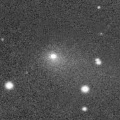
|
It brightened rapidly up to 14.6 mag in winter (Jan. 31, Thomas Lehmann). Now it is 17.1 mag (Sept. 25, ATLAS-MLO, Mauna Loa). Fading gradually. It will be fainter than 18 mag in November. It stays extremely low in the Northern Hemisphere. In the Southern Hemisphere, it stays observable in good condition.
Date(TT) R.A. (2000) Decl. Delta r Elong. m1 Best Time(A, h)
Oct. 18 2 51.88 -47 1.7 2.486 3.114 120 17.6 1:07 ( 0, 8)
Oct. 25 2 42.98 -48 45.9 2.580 3.176 118 17.8 0:31 ( 0, 6)
|
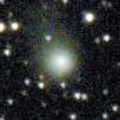
|
It brightened up to 12.1 mag in 2023 spring (May 20, 2023, Jose Guilherme de S. Aguiar). Now it is 17.4 mag (Mar. 25, ATLAS South Africa). It stays 18 mag for a while. It stays observable in good condition.
Date(TT) R.A. (2000) Decl. Delta r Elong. m1 Best Time(A, h)
Oct. 18 6 41.04 -19 44.3 8.015 8.218 98 17.7 4:44 (357, 35)
Oct. 25 6 39.64 -20 0.6 7.975 8.265 103 17.7 4:26 ( 0, 35)
|
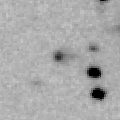
|
Now it is 17.8 mag (Sept. 21, Alfons Diepvens). It stays 18 mag for a while. It will be unobservable in November in the Southern Hemisphere, or in December in the Northern Hemisphere. But it will be observable again in January in the Northern Hemisphere, or in February in the Southern Hemisphere.
Date(TT) R.A. (2000) Decl. Delta r Elong. m1 Best Time(A, h)
Oct. 18 17 17.53 4 38.3 5.498 5.045 58 17.7 18:45 ( 67, 36)
Oct. 25 17 23.53 3 57.0 5.557 5.032 53 17.7 18:38 ( 70, 33)
|

|
Fading slowly. It will be fainter than 18 mag in December. In the Northern Hemisphere, it stays observable in good condition. It locates somewhat low in the Southern Hemisphere.
Date(TT) R.A. (2000) Decl. Delta r Elong. m1 Best Time(A, h)
Oct. 18 3 19.35 43 7.6 1.482 2.327 138 17.9 1:36 (180, 82)
Oct. 25 3 1.18 42 33.0 1.450 2.344 146 17.7 0:50 (180, 82)
|

|
Now it is 17.8 mag (Mar. 17, ATLAS Chile). It stays 18 mag for a while. It stays observable in good condition.
Date(TT) R.A. (2000) Decl. Delta r Elong. m1 Best Time(A, h)
Oct. 18 7 58.26 -10 53.1 4.223 4.194 81 17.8 4:44 (331, 39)
Oct. 25 8 1.52 -11 40.2 4.144 4.204 86 17.8 4:49 (341, 41)
|
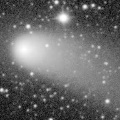
|
It brightened up to 9.6 mag from February to March in 2024 (Feb. 25, 2024, Thomas Lehmann). Now it is 17.9 mag (Sept. 17, Ken-ichi Kadota). Fading slowly. It will be fainter than 18 mag in November. In the Northern Hemisphere, it stays observable in good condition. It stays extremely low in the Southern Hemisphere.
Date(TT) R.A. (2000) Decl. Delta r Elong. m1 Best Time(A, h)
Oct. 18 22 53.24 40 1.4 6.123 6.848 133 17.8 21:05 (180, 85)
Oct. 25 22 51.17 39 7.8 6.216 6.907 130 17.8 20:35 (180, 86)
|
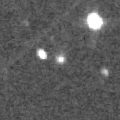
|
Now it is 17.5 mag (Sept. 23, ATLAS-MLO, Mauna Loa). It stays 18 mag for a while. In the Northern Hemisphere, it will be getting lower gradually. In the Southern Hemisphere, it will never be observable after this.
Date(TT) R.A. (2000) Decl. Delta r Elong. m1 Best Time(A, h)
Oct. 18 16 49.81 41 32.2 5.504 5.221 68 17.8 18:45 (116, 46)
Oct. 25 16 54.93 39 57.7 5.556 5.236 66 17.8 18:38 (114, 43)
|

|
Now it is 18.1 mag (Sept. 17, ATLAS-HKO, Haleakala). It stays 18 mag for a while. It stays observable in good condition.
Date(TT) R.A. (2000) Decl. Delta r Elong. m1 Best Time(A, h)
Oct. 18 7 7.24 8 31.4 3.893 4.137 97 17.8 4:44 (340, 62)
Oct. 25 7 9.17 7 58.4 3.804 4.147 103 17.8 4:49 (356, 63)
|
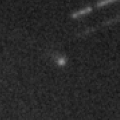
|
Now it is 17.6 mag (Sept. 29, ATLAS Chile). It stays 18 mag for a while. In the Northern Hemisphere, it will never be observable after this. In the Southern Hemisphere, it stays observable in good condition.
Date(TT) R.A. (2000) Decl. Delta r Elong. m1 Best Time(A, h)
Oct. 18 20 20.45 -57 11.2 2.754 2.907 88 17.8 18:45 ( 2, -2)
Oct. 25 20 20.18 -57 43.8 2.841 2.892 82 17.9 18:38 ( 4, -3)
|

|
It brightened up to -3 mag due to the forward scattering in the SOHO coronagraph images (Oct. 9, 2024, Q.-c. Zhang, Charles S. Morris). It became a great comet of 0 mag on the ground. Now it is 17.2 mag (Oct. 2, Thomas Lehmann). Fading slowly. It will be fainter than 18 mag soon. In the Northern Hemisphere, it will be getting lower gradually. It stays extremely low in the Southern Hemisphere.
Date(TT) R.A. (2000) Decl. Delta r Elong. m1 Best Time(A, h)
Oct. 18 17 57.57 14 54.7 5.714 5.462 70 17.8 18:45 ( 70, 50)
Oct. 25 17 59.68 14 15.5 5.869 5.532 65 18.0 18:38 ( 73, 46)
|
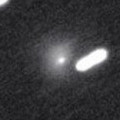
|
It brightened in major outburst of 5 mag. Now it is 18.1 mag (Oct. 11, John Maikner). It stays 18 mag for a while. It will be getting lower gradually.
Date(TT) R.A. (2000) Decl. Delta r Elong. m1 Best Time(A, h)
Oct. 18 19 45.24 -3 16.5 14.904 14.989 93 17.9 18:45 ( 19, 50)
Oct. 25 19 45.80 -3 21.9 15.031 15.003 86 18.0 18:38 ( 26, 49)
|
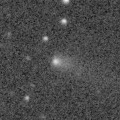
|
Now it is 16.5 mag (Oct. 3, ATLAS Chile). Fading gradually. It stays observable in good condition.
Date(TT) R.A. (2000) Decl. Delta r Elong. m1 Best Time(A, h)
Oct. 18 0 13.14 3 9.2 1.692 2.649 159 18.1 22:25 ( 0, 58)
Oct. 25 0 10.06 2 40.5 1.752 2.670 151 18.2 21:54 ( 0, 58)
|
|
![]()
 C/2022 N2 ( PanSTARRS )
C/2022 N2 ( PanSTARRS ) 29P/Schwassmann-Wachmann 1
29P/Schwassmann-Wachmann 1 C/2023 R1 ( PanSTARRS )
C/2023 R1 ( PanSTARRS ) 24P/Schaumasse
24P/Schaumasse C/2021 G2 ( ATLAS )
C/2021 G2 ( ATLAS ) C/2022 QE78 ( ATLAS )
C/2022 QE78 ( ATLAS ) 88P/Howell
88P/Howell C/2024 J3 ( ATLAS )
C/2024 J3 ( ATLAS ) C/2014 UN271 ( Bernardinelli-Bernstein )
C/2014 UN271 ( Bernardinelli-Bernstein ) 43P/Wolf-Harrington
43P/Wolf-Harrington C/2022 E2 ( ATLAS )
C/2022 E2 ( ATLAS ) C/2024 T5 ( ATLAS )
C/2024 T5 ( ATLAS ) C/2025 L1 ( ATLAS )
C/2025 L1 ( ATLAS ) 78P/Gehrels 2
78P/Gehrels 2 47P/Ashbrook-Jackson
47P/Ashbrook-Jackson 414P/STEREO
414P/STEREO C/2023 C2 ( ATLAS )
C/2023 C2 ( ATLAS ) 65P/Gunn
65P/Gunn C/2024 A1 ( ATLAS )
C/2024 A1 ( ATLAS ) C/2022 R6 ( PanSTARRS )
C/2022 R6 ( PanSTARRS ) 261P/Larson
261P/Larson C/2023 H5 ( Lemmon )
C/2023 H5 ( Lemmon ) 217P/LINEAR
217P/LINEAR 302P/Lemmon-PanSTARRS
302P/Lemmon-PanSTARRS 493P/2024 Q2 ( LONEOS )
493P/2024 Q2 ( LONEOS ) 145P/Shoemaker-Levy 5
145P/Shoemaker-Levy 5 C/2023 F3 ( ATLAS )
C/2023 F3 ( ATLAS ) C/2023 X2 ( Lemmon )
C/2023 X2 ( Lemmon ) C/2024 R4 ( PanSTARRS )
C/2024 R4 ( PanSTARRS ) C/2019 E3 ( ATLAS )
C/2019 E3 ( ATLAS ) C/2023 RS61 ( PanSTARRS )
C/2023 RS61 ( PanSTARRS ) 164P/Christensen
164P/Christensen C/2020 V2 ( ZTF )
C/2020 V2 ( ZTF ) 195P/Hill
195P/Hill C/2025 R1 ( ATLAS )
C/2025 R1 ( ATLAS ) C/2025 J1 ( Borisov )
C/2025 J1 ( Borisov ) C/2025 Q3 ( ATLAS )
C/2025 Q3 ( ATLAS ) C/2017 K2 ( PanSTARRS )
C/2017 K2 ( PanSTARRS ) C/2019 U5 ( PanSTARRS )
C/2019 U5 ( PanSTARRS ) C/2023 H1 ( PanSTARRS )
C/2023 H1 ( PanSTARRS ) C/2023 U1 ( Fuls )
C/2023 U1 ( Fuls ) 48P/Johnson
48P/Johnson C/2024 X2 ( ATLAS )
C/2024 X2 ( ATLAS ) C/2024 J2 ( Wierzchos )
C/2024 J2 ( Wierzchos ) C/2020 K1 ( PanSTARRS )
C/2020 K1 ( PanSTARRS ) C/2024 G4 ( PanSTARRS )
C/2024 G4 ( PanSTARRS ) (3200) Phaethon
(3200) Phaethon 242P/Spahr
242P/Spahr C/2021 S3 ( PanSTARRS )
C/2021 S3 ( PanSTARRS ) C/2024 N3 ( Sarneczky )
C/2024 N3 ( Sarneczky ) 276P/Vorobjov
276P/Vorobjov C/2025 L2 ( MAPS )
C/2025 L2 ( MAPS ) C/2023 A3 ( Tsuchinshan-ATLAS )
C/2023 A3 ( Tsuchinshan-ATLAS ) C/2013 C2 ( Tenagra )
C/2013 C2 ( Tenagra ) 486P/2024 H1 ( Leonard )
486P/2024 H1 ( Leonard )![]()



























































